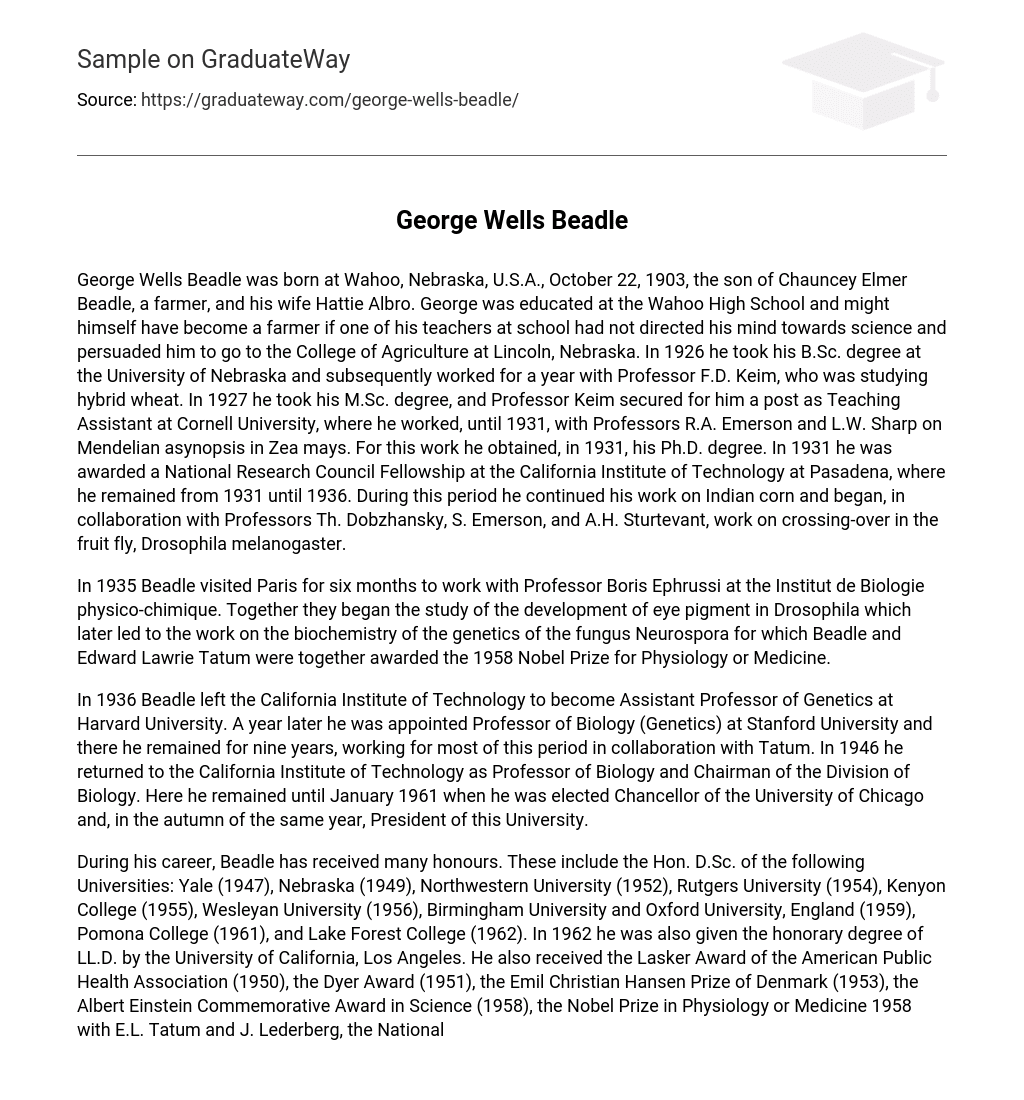George Wells Beadle, born in Wahoo, Nebraska on October 22, 1903, was the son of Chauncey Elmer Beadle and Hattie Albro. In high school, a teacher ignited his interest in science and urged him to enroll at the College of Agriculture in Lincoln, Nebraska.
In 1926, he earned his B.Sc. degree from the University of Nebraska and subsequently worked with Professor F.D. Keim for a year on hybrid wheat research. The following year, in 1927, he completed his M.Sc. degree and secured a Teaching Assistant position at Cornell University with Professor Keim’s help. While at Cornell, he collaborated with Professors R.A. Emerson and L.W. Sharp on Mendelian asynopsis in Zea mays until 1931 when he successfully obtained his Ph.D. degree.
In 1931, he was awarded a National Research Council Fellowship at the California Institute of Technology in Pasadena. He stayed there until 1936, conducting research on Indian corn and working together with Professors Th. Dobzhansky, S. Emerson, and A.H. Sturtevant on investigating crossing-over in Drosophila melanogaster, also known as the fruit fly.
< p > Beadle and Professor Boris Ephrussi worked together at the Institut de Biologie physico-chimique in Paris for six months in 1935. Their research focused on studying the development of eye pigment in Drosophila and later expanded to include the biochemistry of genetics in the fungus Neurospora. This groundbreaking work ultimately led to Beadle and Edward Lawrie Tatum being awarded the Nobel Prize for Physiology or Medicine in 1958. < /p >
Beadle left the California Institute of Technology in 1936 to join Harvard University as an Assistant Professor of Genetics. Later, he became a Professor of Biology (Genetics) at Stanford University and worked there for nine years with Tatum. In 1946, he returned to the California Institute of Technology as a Professor of Biology and Chairman of the Division of Biology until January 1961 when he was elected Chancellor of the University of Chicago. In the same year’s autumn, he also became the President of the University of Chicago.
Throughout his career, Beadle has received a multitude of accolades. He was awarded Honorary Doctor of Science degrees by several universities, including Yale (1947), Nebraska (1949), Northwestern University (1952), Rutgers University (1954), Kenyon College (1955), Wesleyan University (1956), Birmingham University and Oxford University in England (1959), Pomona College (1961), and Lake Forest College (1962).
In 1962, the University of California, Los Angeles honored him with an honorary degree of LL.D. He was also recognized by the American Public Health Association in 1950 with the Lasker Award, in 1951 with the Dyer Award, and in 1953 with the Emil Christian Hansen Prize from Denmark. Further accolades include receiving the Albert Einstein Commemorative Award in Science in 1958 and the National Award from the American Cancer Society in 1959. In addition to these achievements, he was granted the Kimber Genetics Award from the National Academy of Sciences in 1960 and shared a joint Nobel Prize in Physiology or Medicine with E.L. Tatum and J. Lederberg in 1958.
He is a member of multiple learned societies, including the National Academy of Sciences where he serves as Chairman of the Committee on Genetic Effects of Atomic Radiation. He also holds membership in the Genetics Society of America, where he was President in 1946. Additionally, he is a member of the American Association for the Advancement of Science (AAAS), where he served as President in 1955, and the American Cancer Society (ACS), where he serves as Chairman of the Scientific Advisory Council. Furthermore, he is a member of both the Royal Society of London and the Danish Royal Academy of Science.
Beadle is a man who has been married twice. He has a son named David from his first marriage, currently living in The Hague, the Netherlands. His second wife, Muriel McClure, is a well-known writer and was born in California. Beadle’s interests include rock climbing, skiing, and gardening.





